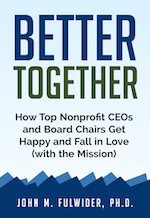“I tried Twitter for awhile,” my friend told me, “but I just didn’t have time for it.”
Me, I love Twitter. So I felt a little defensive, like if she had just told me my kid was ugly or something.
She continued, “People tell me I need to be on it, but I don’t know how me tweeting helps my organization. And it’s hard to follow anyone, because the feed is just cluttered and overwhelming.”
As I listened, I started to reflect on my own Twitter journey. I recalled that, in the beginning, I too found Twitter to be overwhelming. Actually, it was great at first; I found so many interesting people talking about so many interesting things that I followed almost everyone. After only a short time, the flood of great information frustrated me. My response was to simply eject.
It turned around for me, though, when I realized that Twitter is nothing more than a tool. And just like any tool–a hammer, screwdriver, whatever–Twitter is only useful if you know why to use it, how to use it, and when to use it.
What’s your reason for using Twitter?
A good place to start your journey toward Twitter effectiveness is to determine the reason you want to use it in the first place.
- Bad reason: someone at a conference told me I should be on Twitter.
- Good reason: Twitter gives me a continuous feed of current information about people and things that interest me.
- Bad reason: One of my board members said that everyone is on Twitter and we’re missing the boat if we’re not.
- Good reason: We want to provide value to our constituents by curating information that is helpful to them.
Both of the bad reasons above (and most bad reasons for anything we do, incidentally) have a commonality: FOMO (Fear Of Missing Out).
FOMO is one of the most powerful motivating forces on the face of the planet. Unfortunately, it is also one of the least sustainable. Think “flash in the pan” here.
If you don’t have a thoughtful, deliberate reason for using Twitter, you won’t use Twitter. Or, rather, you won’t stick with it.
Your reason can be business or personal, but you have to have one.
Lists: the magic secret to managing your Twitter feed
The biggest key to my Twitter success is lists. I can’t overemphasize this; it was a game-changer for me.
As I laid out above, the best way to waste time on Twitter is to have no purpose. If you want to kill an afternoon, just mindlessly scroll through your Twitter feed. But you don’t want to do that.
Sometimes when I go on Twitter I’m in the mood for motivational stuff. So, I’ve got a list for that. All the follows I have who put out motivational tips are on that list, and when I bring it up all of those creators are in a specific feed. If I’m in the mood for personal development advice, I pull that list up. If I want updates on how my Kansas City Royals are doing, I’ve got a list for that (incidentally, following the progress of a baseball game on Twitter is more fun than actually watching the game, fyi).
I’ve got a “friends and family” list to keep up with the goings-on of the people important to me. An “interesting random stuff” list. A list of my kids’ schools so I can keep updated with critical info.
Wading through my feed to find each of these specific information needs would be impossible. It would also expose me to a whole herd of squirrels (as in, “LOOK! SQUIRREL!”).
CAUTION!: If you add someone to one of your lists, and you didn’t mark the list as “private” when you created it, they will be notified when you add them. So don’t name your list “hairy jerk-faces” and then add someone to it.
Schedule time for Twitter
It is true: Twitter can be a huge distraction and cause you to fritter away shocking amounts of time.
You know what else can be a distraction? Email. And meetings. And phone calls. And Facebook.
Also, television, talking with friends or any activity. Even personal development books, when read at the expense of doing something more relevant to your goals, is a distraction. So this isn’t unique to Twitter.
Back on the farm, we raised corn and wheat. If the wheat was growing in the wheat field, that was good. If the wheat was growing in the corn field, that was bad. The wheat itself didn’t change from good to bad, but the context made all the difference.
Same goes for Twitter. Schedule time to be on Twitter. During that time, be on Twitter. Don’t toggle back and forth among other tasks; focus on Twitter. When it isn’t “Twitter time,” don’t be on Twitter. It’s as simple as that.
When you’re on Twitter, remember why you’re on Twitter and act accordingly. If you’re monitoring what industry leaders are saying and re-Tweeting, then do that. If you’re looking for your own personal development resources to save and read later, do that.
Do you have any awesome tips for taming Twitter?
If you’ve discovered a Twitter hack that works for you, please share it over at the Nonprofit Wizards Facebook page!
 Darren Macfee is the founder of the Nonprofit Wizards. His life purposes are to dispense homespun wisdom, grill a perfect meal for his family, and help nonprofit leaders create amazing results for and through their organizations. Follow him on Twitter @NPWizards or send him a note. Be sure to sign up for alerts to be sure you never miss a post.
Darren Macfee is the founder of the Nonprofit Wizards. His life purposes are to dispense homespun wisdom, grill a perfect meal for his family, and help nonprofit leaders create amazing results for and through their organizations. Follow him on Twitter @NPWizards or send him a note. Be sure to sign up for alerts to be sure you never miss a post.

 The Effective Executive: The Definitive Guide to Getting the Right Things Done by Peter F. Drucker
The Effective Executive: The Definitive Guide to Getting the Right Things Done by Peter F. Drucker

The Bully Pulpit: Theodore Roosevelt, William Howard Taft, and the Golden Age of Journalism by Doris Kearns Goodwin
 Good to Great: Why Some Companies Make the Leap…And Others Don’t by Jim Collins.
Good to Great: Why Some Companies Make the Leap…And Others Don’t by Jim Collins.

The Policy Governance Model and the Role of the Board Member by John Carver
 The Slight Edge: Turning Simple Disciplines into Massive Success and Happiness
The Slight Edge: Turning Simple Disciplines into Massive Success and Happiness by Jeff Olson

Better Together: How Top Nonprofit CEOs and Board Chairs Get Happy, Fall in Love and Change Their World by John M. Fulwider, Ph.D.
The ONE Thing: The Surprisingly Simple Truth Behind Extraordinary Results by Gary Keller
Some titles above are affiliate links. If you’re not sure why you should care click here. You’ll also learn how you can help feed the children.
Newsletter


